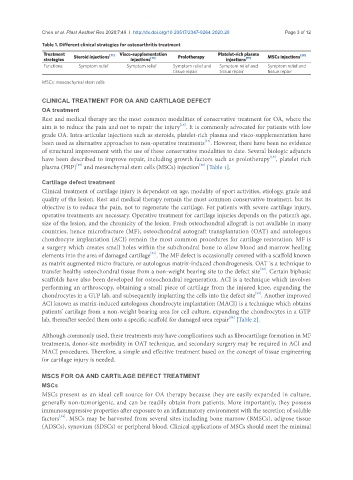Page 565 - Read Online
P. 565
Chen et al. Plast Aesthet Res 2020;7:49 I http://dx.doi.org/10.20517/2347-9264.2020.28 Page 3 of 12
Table 1. Different clinical strategies for osteoarthritis treatment
Treatment [77] Visco-supplementation Platelet-rich plasma [20]
strategies Steroid injections injections [78] Prolotherapy injections [19] MSCs injections
Functions Symptom relief Symptom relief Symptom relief and Symptom relief and Symptom relief and
tissue repair tissue repair tissue repair
MSCs: mesenchymal stem cells
CLINICAL TREATMENT FOR OA AND CARTILAGE DEFECT
OA treatment
Rest and medical therapy are the most common modalities of conservative treatment for OA, where the
aim is to reduce the pain and not to repair the injury . It is commonly advocated for patients with low
[16]
grade OA. Intra-articular injections such as steroids, platelet-rich plasma and visco-supplementation have
[17]
been used as alternative approaches to non-operative treatments . However, there have been no evidence
of structural improvement with the use of these conservative modalities to date. Several biologic adjuncts
[18]
have been described to improve repair, including growth factors such as prolotherapy , platelet rich
[19]
[20]
plasma (PRP) and mesenchymal stem cells (MSCs) injection [Table 1].
Cartilage defect treatment
Clinical treatment of cartilage injury is dependent on age, modality of sport activities, etiology, grade and
quality of the lesion. Rest and medical therapy remain the most common conservative treatment, but its
objective is to reduce the pain, not to regenerate the cartilage. For patients with severe cartilage injury,
operative treatments are necessary. Operative treatment for cartilage injuries depends on the patient’s age,
size of the lesion, and the chronicity of the lesion. Fresh osteochondral allograft is not available in many
countries, hence microfracture (MF), osteochondral autograft transplantation (OAT) and autologous
chondrocyte implantation (ACI) remain the most common procedures for cartilage restoration. MF is
a surgery which creates small holes within the subchondral bone to allow blood and marrow healing
[21]
elements into the area of damaged cartilage . The MF defect is occasionally covered with a scaffold known
as matrix augmented micro fracture, or autologous matrix-induced chondrogenesis. OAT is a technique to
transfer healthy osteochondral tissue from a non-weight bearing site to the defect site . Certain biphasic
[22]
scaffolds have also been developed for osteochondral regeneration. ACI is a technique which involves
performing an arthroscopy, obtaining a small piece of cartilage from the injured knee, expanding the
[23]
chondrocytes in a GTP lab, and subsequently implanting the cells into the defect site . Another improved
ACI known as matrix-induced autologous chondrocyte implantation (MACI) is a technique which obtains
patients’ cartilage from a non-weight bearing area for cell culture, expanding the chondrocytes in a GTP
[24]
lab, thereafter seeded them onto a specific scaffold for damaged area repair [Table 2].
Although commonly used, these treatments may have complications such as fibrocartilage formation in MF
treatments, donor-site morbidity in OAT technique, and secondary surgery may be required in ACI and
MACI procedures. Therefore, a simple and effective treatment based on the concept of tissue engineering
for cartilage injury is needed.
MSCS FOR OA AND CARTILAGE DEFECT TREATMENT
MSCs
MSCs present as an ideal cell source for OA therapy because they are easily expanded in culture,
generally non-tumorigenic, and can be readily obtain from patients. More importantly, they possess
immunosuppressive properties after exposure to an inflammatory environment with the secretion of soluble
[25]
factors . MSCs may be harvested from several sites including bone marrow (BMSCs), adipose tissue
(ADSCs), synovium (SDSCs) or peripheral blood. Clinical applications of MSCs should meet the minimal

